The Night Sky April 2012
Compiled by Ian Morison
Saturn in ascendant
This page, updated monthly, will let you know some of the things that you can look out for in the night sky. It lists the phases of the Moon, where you will see the naked-eye planets and describes some of the prominent constellations in the night sky during the month.
Image of the Month
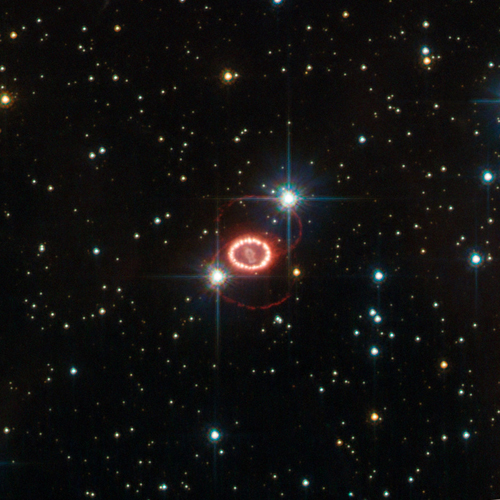
Supernova 1987a
ESA/Hubble, NASA
ESA/Hubble, NASA
In February 1987 a supernova was seen to explode in the Large Magellanic Cloud. Around 260 days later a ring of material that had previously been ejected by the star was excited by the ultraviolet light emitted as the star exploded and began to glow. Further away from the supernova two flattened outer rings have appeared. Their origin is still a mystery but could perhaps be caused by beamed jets emanating from a hidden neutron star resulting from the supernova explosion or caused by material ejected by the supernova interacting with gas released, as in the smaller ring, during the unstable phase of the star prior to its explosion.
It might be worth noting that the neutrinos emitted as the star exploded arrived close to the time at which the first visible light was seen and indicate that they were travelling just slower than the speed of light.
Highlights of the Month
April: Observe Saturn in the evening sky
To see some of Damian Peache's Saturn Images: Damian Peache's website
Saturn is now rising in the southern sky during the evening and will lie due south around midnight (UT) when at opposition on April 15th. It lies in the constellation Virgo close to the its brightest star Spica. The rings are now ~14 degrees from the line of site and so Saturn appears brighter than for a couple of years, but it will not be until 2018 that they will be at their widest again. It is one of the most beautiful objects in the heavens and though you will never see all the detail that is shown in the Cassini images - or even those made by Damian Peache - your first view of Saturn and its rings will never be forgotten. It takes Saturn 29.4 years to complete one orbit. Due to the tilt of its rotation axis, for half this time we see the northern hemisphere best and for the other half the southern hemisphere. Following the time when we saw the rings edge on a year or so ago, we are now seeing the northern hemisphere. Though not as prominent as those in Jupiter's atmosphere, there are belts and zones in the which can be seen. The belts are thought to be warmer gasses low down in the atmosphere whilst the brighter zones are thought to be ice crystals and clouds in the upper, colder, atmosphere. A small telescope will show the two brightest rings, the outer A ring and the closer in B or Bright ring. These are separated by Cassini's Division. With a ~8" aperture telescope and a night of good seeing, one may also spot Encke's division towards the outer edge of the A ring. A small telescope will also easily show its largest moon, Titan. See further details below in the "Planets" section.
The Lyrid meteor Shower on the night of 22/23rd April
The Lyrid Meteor Shower - so called as the radiant (from where the meteor trails seem to radiate from) lies in the constellation Lyra peaks in the early morning of the 22nd April and is a reliable, though not spectacular, shower with perhaps up to 15 meteors seen per hour. Observations of the Lyrid meteors have been made for at least 2,600 years! Happily, this year the peak of activity is only one day after the new moon so there will be no moonlight to hinder our observations should it be clear. Observations made after 1 am are expected to be the most productive. The dust particles that cause the shower have been released by the comet Thatcher, discovered in 1861. Occasionally we pass through a dense clump of particles as happened in 1982 when over 90 meteors were seen per hour. So its worth waking up to have a look if around 1-2 am should it be expected to be clear. Look to the East as shown in the chart.
April 3rd: Venus passes the Pleaides Cluster
Every 8 years, Venus passes close to the Pleiades Cluster making a very nice celestial event to view or image. This year, it passes just below and to the left of the brightest stars in the cluster, passing just half a degree away from Alcyone. In 2020 years time will come closer still and in 2028 will pass through the centre of the cluster.
April 30th - after sunset: Mars and a 9 day old Moon
On the last day of the month as darkness falls, a 9 day old Moon will be seen just below the salmon-pink disk of Mars lying close to Regulus in Leo.
April 19th: Saturn and its moons
On the 19th April with no Moon in the sky and a reasonable sized telescope there is a nice grouping of the satellites of Saturn to be seen in the late evening. Even the smallest of telescopes will show 9th magnitude Titan.
April 24th: Venus and a thin crescent Moon.
After sunset on the 24th, you may, given a low south western horizon and clear skies, be able to spot Venus at magnitude -4.6 above a thin crescent Moon. Look out for the "earthshine" illuminating the "dark side" of the Moon - often called the "old Moon in the new Moon's arms".
April 12th and 29th: The Alpine Valley
An interesting valley on the Moon: The Alpine Valley
These are two good nights to observe an interesting feature on the Moon if you have a small telescope. Close to the limb is the Appenine mountain chain that marks the edge of Mare Imbrium. Towards the upper end you should see the cleft across them called the Alpine valley. It is about 7 miles wide and 79 miles long. As shown in the image is a thin rill runs along its length which is quite a challenge to observe. The dark crater Plato will also be visible nearby. You may also see the shadow cast by the mountain Mons Piton lying not far away in Mare Imbrium. This is a very interesting region of the Moon!
These are two good nights to observe an interesting feature on the Moon if you have a small telescope. Close to the limb is the Appenine mountain chain that marks the edge of Mare Imbrium. Towards the upper end you should see the cleft across them called the Alpine valley. It is about 7 miles wide and 79 miles long. As shown in the image is a thin rill runs along its length which is quite a challenge to observe. The dark crater Plato will also be visible nearby. You may also see the shadow cast by the mountain Mons Piton lying not far away in Mare Imbrium. This is a very interesting region of the Moon!
M16, the Eagle nebula, imaged with the Faulkes Telescope
The Eagle Nebula, M16, imaged by Daniel Duggan.
This image was taken using the Faulkes Telescope North by Daniel Duggan - for some time a member of the Faulkes telescope team. It is a region of dust and gas where stars are now forming. The ultraviolet light from young blue stars is stripping the electrons from hydrogen atoms so this region contains ionized hydrogen and is called an HII region. As the electrons drop back down through the hydrogen energy levels as the atoms re-form, red light at the H alpha wavelength is emitted. This "true colour" image is composed of red, green and blue images along with a narrow band H alpha image. A Hubble image of the central region, called the "Pillars of Creation", has become quite famous but looks green/blue in colour. This is a false colour image where the H alpha image has been encoded as green!
This image was taken using the Faulkes Telescope North by Daniel Duggan - for some time a member of the Faulkes telescope team. It is a region of dust and gas where stars are now forming. The ultraviolet light from young blue stars is stripping the electrons from hydrogen atoms so this region contains ionized hydrogen and is called an HII region. As the electrons drop back down through the hydrogen energy levels as the atoms re-form, red light at the H alpha wavelength is emitted. This "true colour" image is composed of red, green and blue images along with a narrow band H alpha image. A Hubble image of the central region, called the "Pillars of Creation", has become quite famous but looks green/blue in colour. This is a false colour image where the H alpha image has been encoded as green!
Learn more about the Faulkes Telescopes and how schools can use them: Faulkes Telescope"
Observe the International Space Station

The International Space Station and Jules Verne passing behind the Lovell Telescope on April 1st 2008.
Image by Andrew Greenwood
Use the link below to find when the space station will be visible in the next few days. In general, the space station can be seen either in the hour or so before dawn or the hour or so after sunset - this is because it is dark and yet the Sun is not too far below the horizon so that it can light up the space station. As the orbit only just gets up the the latitude of the UK it will usually be seen to the south, and is only visible for a minute or so at each sighting. Note that as it is in low-earth orbit the sighting details vary quite considerably across the UK. The NASA website linked to below gives details for several cities in the UK. (Across the world too for foreign visitors to this web page.)
Note: I observed the ISS three times recently and was amazed as to how bright it has become.
Find details of sighting possibilities from your location from: Location Index
See where the space station is now: Current Position
The Moon

The Moon at 3rd Quarter. Image, by Ian Morison, taken with a 150mm Maksutov-Newtonian and Canon G7.
Just below the crator Plato seen near the top of the image is the mountain "Mons Piton". It casts a long shadow across the maria from which one can calculate its height - about 6800ft or 2250m.
| new moon | first quarter | full moon | last quarter |
|---|---|---|---|
| April 21st | April 29th | April 6th | April 13th |
Some Lunar Images by Ian Morison, Jodrell Bank Observatory: Lunar Images
A World Record Lunar Image
To mark International Year of Astronomy, a team of British astronomers have made the largest lunar image in history and gained a place in the Guinness Book of Records! The whole image comprises 87.4 megapixels with a Moon diameter of 9550 pixels. This allows details as small as 1km across to be discerned! The superb quality of the image is shown by the detail below of Plato and the Alpine Valley. Craterlets are seen on the floor of Plato and the rille along the centre of the Alpine valley is clearly visible. The image quality is staggering! The team of Damian Peach, Pete lawrence, Dave Tyler, Bruce Kingsley, Nick Smith, Nick Howes, Trevor Little, David Mason, Mark and Lee Irvine with technical support from Ninian Boyle captured the video sequences from which 288 individual mozaic panes were produced. These were then stitched together to form the lunar image.
Please follow the link to the Lunar World Record website and it would be really great if you could donate to Sir Patrick Moore's chosen charity to either download a full resolution image or purchase a print.
The Planets
Jupiter
Jupiter is now close to the end of its current apparition but can still be seen below Venus low in the the western sky after sunset as April begins. It then sets some two and a half hours after the Sun the but this drops to just three quarters of an hour by month's end. Its magnitude at -2 is two and a half magnitudes less than Venus - a factor of more than 7 times less in brightness. With an angular size of ~34 arc during the month, a small telescope will still show the equatorial belts (the south equatorial belt has reappeared) and the four Galilean moons but the low elevation will hinder any observations. Observing it in the last few weeks has shown some prominent dark regions in the north equatorial belt. These are called "barges".
Saturn
Saturn rises about one hour after sunset at the beginning of the month, and reaches opposition on April 15th when it will be roughly due south at midnight (UT) at an elevation of ~32 degrees. It lies in Virgo, shining at magnitude +0.3, some 5 degree slightly up and to the left of the first magnitude star Spica. Sadly, in contrast to Jupiter, Saturn is heading to the more southerly parts of the ecliptic so, for quite some considerable time, will not be seen high above the horizon from our northern climes. However the rings have opened out nicely and are now ~14 degrees to the line of sight, so will appear appreciably wider than we have seen during its last apparition. (This angle actually drops down to 13 degrees during the month and will continue to do so for a few months.) It is now well be worth having a look at its 19 arc second disk and ring system. With a small telescope on a night of good seeing, you should be able to easily spot Cassini's Division within the ring system, and given a scope with an aperture of 6 inches or greater and a night of excellent seeing one might even spot Encke's division in the outer A-ring and also the inner, elusive, C-ring.
See highlight above.Mercury
Mercury, reaches its greatest eastern elongation from the Sun on April 18th but, as the ecliptic is at a shallow angle to the dawn horizon, its elevation will be very low and binoculars will almost certainly need to be used to spot it about half an hour before sunrise shining at magnitude ~+0.2 in the east. To be honest, its not worth getting up for.
Mars
Mars reached opposition on March 3rd so, as April begins, is now well up in the evening sky lying just 5 degrees to the left of Regulus, in Leo. As it ends its retrograde motion westwards across the sky on April 15th, it barely moves against the stars during the month but fades in magnitude from -0.7 to -0.1. At the same time its angular diameter shrinks from just over 12 arc seconds down to 10 arc seconds but, given a night of good seeing it should still be possible to see some markings on the surface.
Venus
Venus, which made a nice grouping with Jupiter last month, is still prominent in the south-western sky after sunset. Its angular separation from the Sun at the start of the month is ~45 degrees and, at sunset will be ~41 degrees above the horizon - about as high an elevation as it ever gets so this is a very good time to observe it. These values only reduce to 39 and 34 degrees during the month - such a high apparition only happens once every 8 years. Its angular size is increasing - from 25 to 36 arc seconds during the month - but as it does so its phase (the percentage that we see illuminated) is falling from 48 to 37%. One interesting result is that Venus's brightness stays remarkably constant at magnitude -4.5 to -4.7 throughout the month. During the first three days of the month Venus lies close to the Pleides cluster and then moves across Taurus passing ~10 degrees north of Aldebaran and the Hyades cluster at mid month. Observing Venus through a deep blue filter may enable one to see a hint of the cloud structure in its atmosphere, but it is very subtle!
See highlight above.
Find more planetary images and details about the Solar System: The Solar System
The mid evening April Sky
This map shows the constellations seen in the south in mid-evening.
The constellation Gemini is now setting towards the south-west and Leo holds pride (sic) of place in the south with its bright star Regulus. Between Gemini and Leo lies Cancer. Close to the boundary of these two constellation is where, this month, the planet Saturn may be found. It is well worth observing with binoculars to see the Beehive Cluster at its heart. Below Gemini is the tiny constellation of Canis Minor whose only bright star is Procyon. Rising in the south-east is the constellationVirgo whose brightest star is Spica. Though Virgo has few bright stars it is in the direction of of a great cluster of galaxies - the Virgo Cluster - which lies at the centre of the supercluster of which our local group of galaxies is an outlying member. The constellation Ursa Major is high in the northern sky during the evening this month and contains many interesting objects.
The constellation Gemini
Gemini - The Twins - lies up and to the left of Orion and is in the south-west during early evenings this month. It contains two bright stars Castor and Pollux of 1.9 and 1.1 magnitudes respectivly. Castor is a close double having a separation of ~ 3.6 arc seconds making it a fine test of the quality of a small telescope - providing the atmospheric seeing is good! In fact the Castor system has 6 stars - each of the two seen in the telescope is a double star, and there is a third, 9th magnitude, companion star 73 arcseconds away which is alos a double star! Pollux is a red giant star of spectral class K0. The planet Pluto was discovered close to delta Geminorum by Clyde Tombaugh in 1930. The variable star shown to the lower right of delta Geminorum is a Cepheid variable, changing its brightness from 3.6 to 4.2 magnitudes with a period of 10.15 days
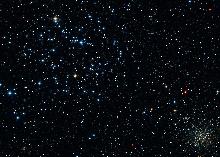
M35 and NGC 2158
This wonderful image was taken by Fritz Benedict and David Chappell using a 30" telescope at McDonal Observatory. Randy Whited combined the three colour CCD images to make the picture
M35 is an open star cluster comprising several hundred stars around a hundred of which are brighter than magnitude 13 and so will be seen under dark skies with a relativly small telescope. It is easily spotted with binoculars close to the "foot" of the upper right twin. A small telescope at low power using a wide field eyepiece will show it at its best. Those using larger telescopes - say 8 to 10 inches - will spot a smaller compact cluster NGC 2158 close by. NGC 2158 is four times more distant that M35 and ten times older, so the hotter blue stars will have reached the end of their lives leaving only the longer-lived yellow stars like our Sun to dominate its light.
To the lower right of the constellation lies the Planetary Nebula NGC2392. As the Hubble Space Telescope image shows, it resembles a head surrounded by the fur collar of a parka hood - hence its other name The Eskimo Nebula. The white dwarf remnant is seen at the centre of the "head". The Nebula was discovered by William Herschel in 1787. It lies about 5000 light years away from us.
The constellation Leo
The constellation Leo is now in the south-eastern sky in the evening. One of the few constellations that genuinely resembles its name, it looks likes one of the Lions in Trafalger Square, with its main and head forming an arc (called the Sickle) to the upper right, with Regulus in the position of its right knee. Regulus is a blue-white star, five times bigger than the sun at a distance of 90 light years. It shines at magnitude 1.4. Algieba, which forms the base of the neck, is the second brightest star in Leo at magnitude 1.9. With a telescope it resolves into one of the most magnificent double stars in the sky - a pair of golden yellow stars! They orbit their common centre of gravity every 600 years. This lovely pair of orange giants are 170 light years away.
Leo also hosts two pairs of Messier galaxies which lie beneath its belly. The first pair lie about 9 degrees to the west of Regulus and comprise M95 (to the east) and M96. They are almost exactly at the same declination as Regulus so, using an equatorial mount, centre on Regulus, lock the declination axis and sweep towards the west 9 degrees. They are both close to 9th magnitude and may bee seen together with a telescope at low power or individually at higher powers. M65 is a type Sa spiral lying at a distance of 35 millin klight years and M66, considerably bigger than M65, is of type Sb. Type Sa spirals have large nuclei and very tightly wound spiral arms whilst as one moves through type Sb to Sc, the nucleus becomes smaller and the arms more open.
The second pair of galaxies, M95 and M96, lie a further 7 degrees to the west between the stars Upsilon and Iota Leonis. M95 is a barred spiral of type SBb. It lies at a distance of 38 million light years and is magnitude 9.7. M96, a type Sa galaxy, is slightly further away at 41 million light years, but a little brighter with a magnitude of 9.2. Both are members of the Leo I group of galaxies and are visible together with a telescope at low power.
There is a further ~9th magnitude galaxy in Leo which, surprisingly, is in neither the Messier or Caldwell catalogues. It lies a little below lambda Leonis and was discovered by William Herschel. No 2903 in the New General Catalogue, it is a beautiful type Sb galaxy which is seen at somewhat of an oblique angle. It lies at a distance of 20.5 million light years.
The constellation Virgo
Virgo, rising in the east in late evening this month, is not one of the most prominent constellations, containing only one bright star, Spica, but is one of the largest and is very rewarding for those with "rich field" telescopes capable of seeing the many galaxies that lie within its boundaries. Spica is, in fact, an exceedingly close double star with the two B type stars orbiting each other every 4 days. Their total luminosity is 2000 times that of our Sun. In the upper right hand quadrant of Virgo lies the centre of the Virgo Cluster of galaxies. There are 13 galaxies in the Messier catalogue in this region, all of which can be seen with a small telescope. The brightest is the giant elliptical galaxy, M87, with a jet extending from its centre where there is almost certainly a massive black hole into which dust and gas are falling. This releases great amounts of energy which powers particles to reach speeds close to the speed of light forming the jet we see. M87 is also called VIRGO A as it is a very strong radio source.
Below Porrima and to the right of Spica lies M104, an 8th magnitude spiral galaxy about 30 million light years away from us. Its spiral arms are edge on to us so in a small telescope it appears as an elliptical galaxy. It is also known as the Sombrero Galaxy as it looks like a wide brimmed hat in long exposure photographs.
The constellation Ursa Major
The stars of the Plough, shown linked by the thicker lines in the chart above, form one of the most recognised star patterns in the sky. Also called the Big Dipper, after the soup ladles used by farmer's wives in America to serve soup to the farm workers at lunchtime, it forms part of the Great Bear constellation - not quite so easy to make out! The stars Merak and Dubhe form the pointers which will lead you to the Pole Star, and hence find North. The stars Alcor and Mizar form a naked eye double which repays observation in a small telescope as Mizar is then shown to be an easily resolved double star. A fainter reddish star forms a triangle with Alcor and Mizar.
Ursa Major contains many interesting "deep sky" objects. The brightest, listed in Messier's Catalogue, are shown on the chart, but there are many fainter galaxies in the region too. In the upper right of the constellation are a pair of interacting galaxies M81 and M82 shown in the image below. M82 is undergoing a major burst of star formation and hence called a "starburst galaxy". They can be seen together using a low power eyepiece on a small telescope.
Another, and very beautiful, galaxy is M101 which looks rather like a pinwheel firework, hence its other name the Pinwheel Galaxy. It was discovered in1781 and was a late entry to Messier's calalogue of nebulous objects. It is a type Sc spiral galaxy seen face on which is at a distance of about 24 million light years. Type Sc galaxies have a relativly small nucleus and open spiral arms. With an overall diameter of 170,000 light it is one of the largest spirals known (the Milky Way has a diameter of ~ 130,000 light years).
Though just outside the constellation boundary, M51 lies close to Alkaid, the leftmost star of the Plough. Also called the Whirlpool Galaxy it is being deformed by the passage of the smaller galaxy on the left. This is now gravitationally captured by M51 and the two will eventually merge. M51 lies at a distance of about 37 million light years and was the first galaxy in which spiral arms were seen. It was discovered by Charles Messier in 1773 and the spiral structure was observed by Lord Rosse in 1845 using the 72" reflector at Birr Castle in Ireland - for many years the largest telescope in the world.
Lying close to Merak is the planetary nebula M97 which is usually called the Owl Nebula due to its resemblance to an owl's face with two large eyes. It was first called this by Lord Rosse who drew it in 1848 - as shown in the image below right. Planetary nebulae ar the remnants of stars similar in size to our Sun. When all possible nuclear fusion processes are complete, the central core collpses down into a "white dwarf" star and the the outer parts of the star are blown off to form the surrounding nebula.

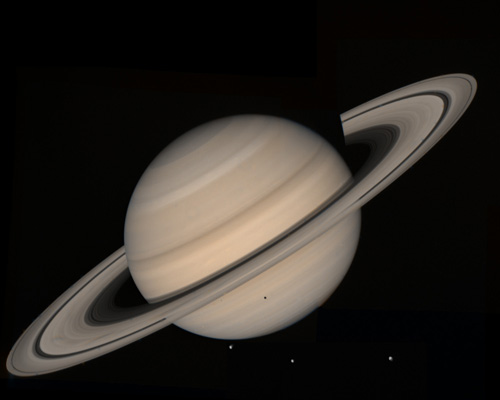
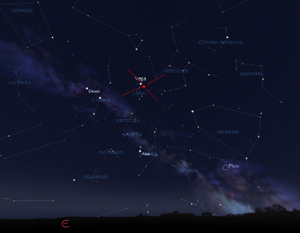
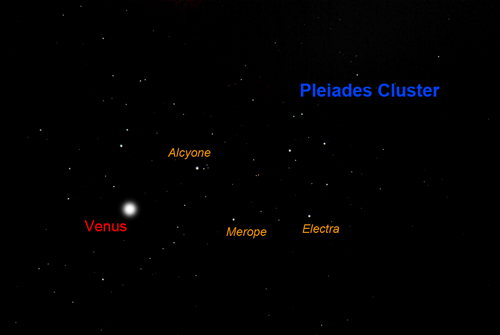
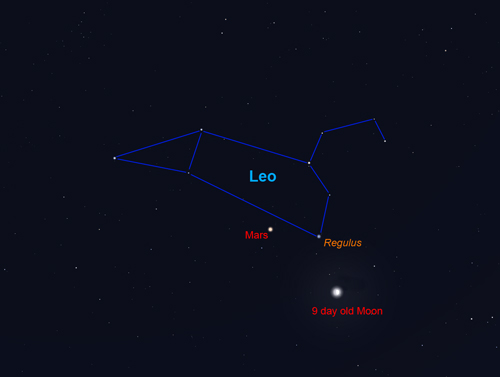
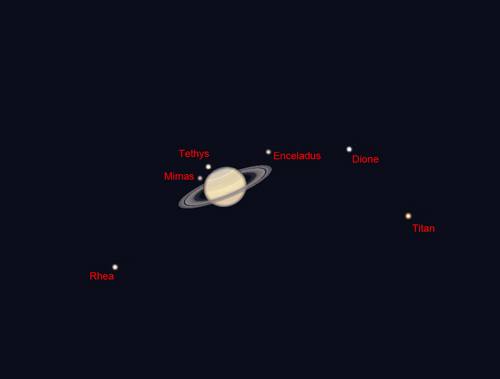
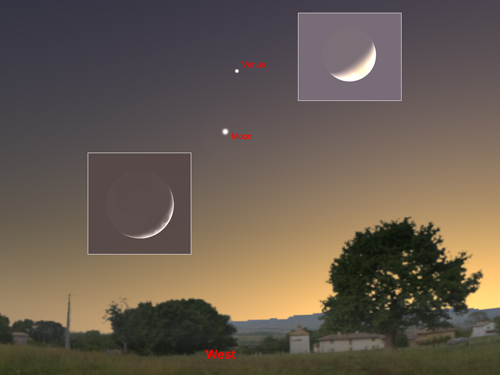
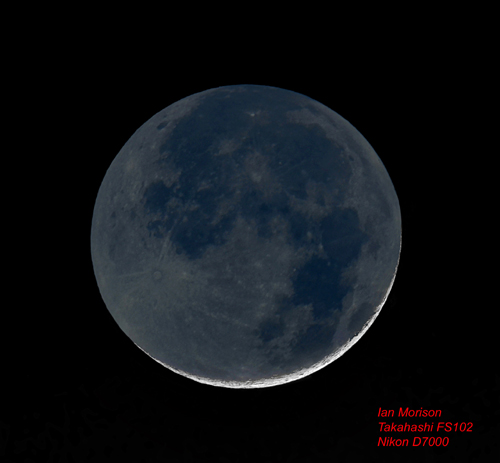
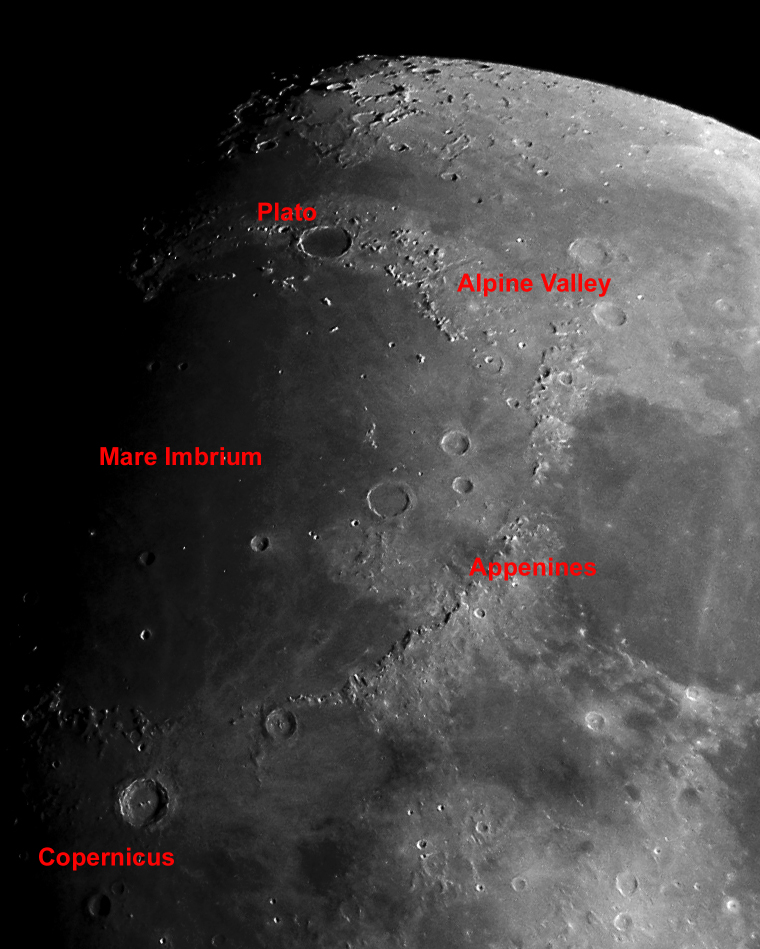

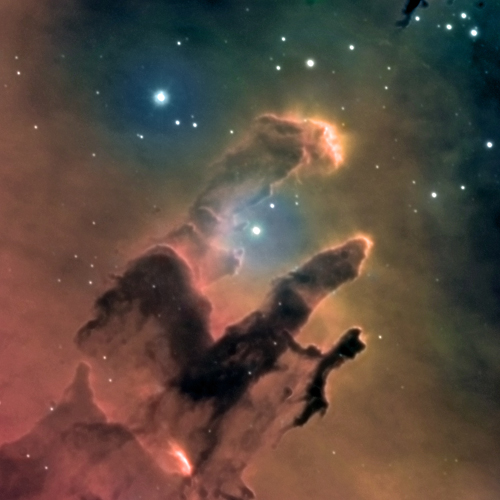









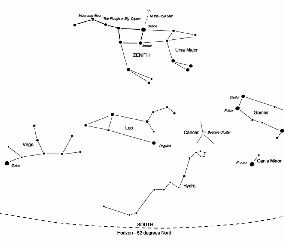

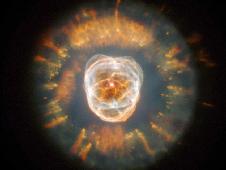
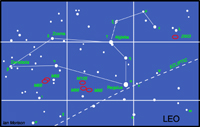
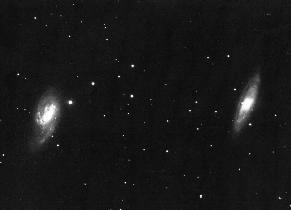
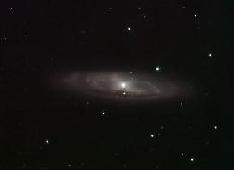
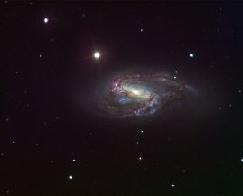
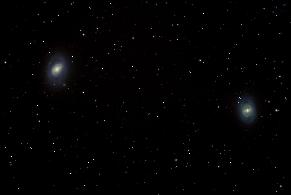
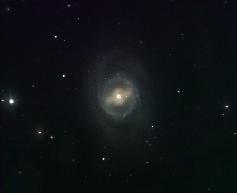
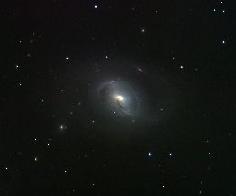
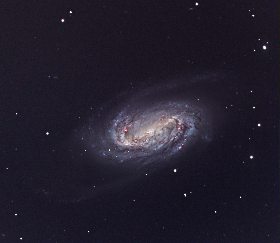












No comments:
Post a Comment